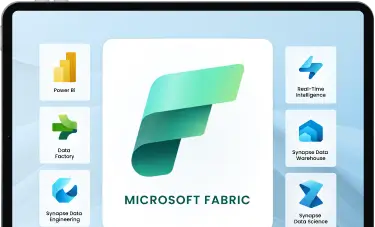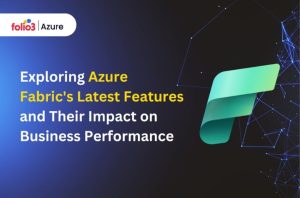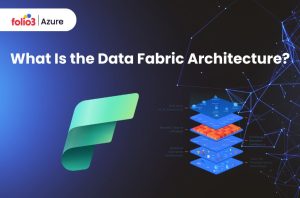Table of Contents
ToggleThe manufacturing industry has become breakneck due to the shift towards hyper-automation in every business sector. Therefore, highly accurate and timely production data reporting is mandatory for optimizing operations and making intelligent decisions based on precise data. Implementing rapid data reporting systems can boost production data analytics.
This article elaborates on how Microsoft Fabric implementation for production data reporting can efficiently handle data integration challenges, refine data accuracy, and provide scalable solutions for your business.
Accelerate smart decisions with Microsoft Fabric's unified data and AI analytics.

Understanding Production Data Reporting
Production data reporting consists of collecting, analyzing, and presenting data gathered during manufacturing processes. Powerful reporting systems facilitate stakeholders by providing access to accurate and actionable insights that lead them to make informed decisions and refine processes.
Conventional reporting methods often face hurdles such as data integration challenges and data accuracy issues across sources. Gaining an understanding of these systems is necessary for realizing how important perfect reporting is.
Production data includes information about machinery performance, production rates, downtime, and quality metrics. Accurate production data analytics empower manufacturers to identify hurdles, simplify processes, and boost productivity. By employing powerful data reporting tools, businesses can remain proactive and competitive through better decision-making and planning.
Furthermore, efficient production data reporting systems support compliance with regulations and industry standards. Ensuring that all necessary information is appropriately recorded, saved, and reported minimizes the probability of non-compliance and fines. They promote a culture of continuous improvement by setting goals, tracking performance, and measuring progress over time.
Common Challenges in Production Data Reporting
Businesses face various challenges when it comes to production data reporting. Let’s discuss some of them.
1. Data Silos
Data is frequently kept in separate systems and in spread-out manufacturing locations, which leads to data silos that hinder practical analysis and reporting. Integrating data from numerous sources can be difficult and time-consuming, and it frequently results in delayed or incomplete insights.
A unified picture of production processes is difficult to obtain because of data silos caused by old systems, disparate software platforms, and various data formats.
2. Data Accuracy and Consistency
Ensuring that data is accurate and consistent across different sources is a huge challenge. Inaccurate data can lead to faulty analyses and weak decision-making, affecting the overall efficiency of the production process.
Moreover, different data entry methods, human errors, and obsolete information lead to inconsistencies that can cripple the reliability of production data reporting systems.
3. Timeliness of Data
Real-time data is the backbone of efficient production management. Delays in data reporting can lead to missed opportunities for improvement and prompt response to production problems.
If recent data can be accessed quickly, it leads to proactive decision-making, empowering manufacturers to handle possible problems before they become huge issues. However, strong infrastructure and smooth data integration are necessary to achieve real-time data reporting.
In addition, there are challenges related to data security and privacy. Production data often consists of sensitive information, so safeguarding it from unauthorized access is crucial. Implementing strict security measures and compliance protocols is vital to maintaining data integrity and confidentiality.
Benefits of Using Microsoft Fabric for Production Data Reporting
Microsoft Fabric provides a powerful solution to overcome these issues, providing a complete framework for optimizing production data reporting.
Enhanced Data Integration
Connecting Disparate Data Sources:
Microsoft Fabric has excellent capability to connect various data sources, breaking down silos and facilitating a smooth flow of data. This integration ensures that data is available for analysis and reporting, providing a complete view of production processes. Manufacturers can collect data from numerous systems by utilizing Microsoft Fabric, creating a comprehensive data reporting framework.
Real-time Data Updates:
Real-time data updates from Microsoft Fabric guarantee that decision-makers have access to the latest information. This is crucial for producing timely data analytics and responding quickly to changes on the factory floor. Updates to real-time data increase awareness of the situation, allowing manufacturers to make decisions based on the most recent information.
Improved Data Accuracy and Consistency
Automated Data Validation:
Microsoft Fabric is equipped with automated data validation processes that ensure data accuracy. By reducing manual input, the risk of errors is minimized, which produces reliable information. Automated validation systems detect abnormalities and inconsistencies in the data and ensure that accurate data is used for reporting and analysis.
Consistent Data Transformation Processes:
Microsoft Fabric provides data transformation processes that transform and present data in a standard format. This is critical for maintaining the integrity of production data reporting systems. Standardized transformation workflows eradicate data discrepancies and ensure that data from different sources is in a uniform format, thus refining data reporting.
Better Data Visualization and Reporting
Advanced Visualization Tools:
Microsoft Fabric provides advanced features for data visualization that help convert complicated data into clear, valuable insights. These tools enable users to generate informative visual reports that help them understand production data. Interactive dashboards, graphs, and charts that clearly and concisely represent production data are examples of advanced visualization capabilities.
Customizable Dashboards:
Microsoft Fabric empowers users to create customized dashboards to meet their unique requirements and preferences. Owing to this flexibility, data reporting systems become successful by enabling stakeholders to focus on the most important information in their roles. Users may personalize their dashboard displays using customizable dashboards, giving priority to the indicators that are most important to them and enabling excellent data monitoring.
Scalability and Flexibility
Easily Scalable Infrastructure:
Microsoft Fabric’s infrastructure can be easily scaled. It accommodates the influx of production data reporting needs. As manufacturing operations expand, the platform can smoothly handle increased data volumes without compromising performance. Scalability ensures that the data reporting system can grow with the organization, supporting long-term goals.
Flexible Integration with Other Tools:
The platform is also flexible in terms of its integration capabilities, enabling it to work seamlessly with various other tools and systems. This compatibility ensures that Microsoft Fabric can fit into existing IT infrastructure, simplifying the implementation process.
Flexible integration also enables manufacturers to maximize the benefits of their current investments in software and hardware, reducing the need for extra changes to existing systems.
Implementing Microsoft Fabric for Production Data Reporting
Implementing Microsoft Fabric requires a systematic approach to ensure successful integration of production data reporting.
1. Assessing Current Data Reporting Infrastructure
The first step in the implementation process is to analyze the existing data reporting infrastructure, detecting gaps and areas for improvement. This practice helps plan an effective fabric implementation strategy. An in-depth analysis consists of evaluating data sources, data quality, reporting processes, and technology infrastructure.
2. Planning and Designing the Fabric Architecture
Meticulous planning and design of the fabric architecture are the foundation for successful fabric implementation and production data reporting. This process involves determining the best ways to integrate various data sources and setting up the infrastructure to support real-time data updates and reporting. When planning, consider factors such as data volume, data flow, integration requirements, and scalability.
3. Data Integration and Migration
After designing the architecture, the next step is integrating and migrating data from existing systems to Microsoft Fabric. This step involves ensuring that data transmission is smooth and that all relevant information is captured. Data migration should be carefully executed to minimize disruption and ensure data integrity.
4. Setting Up Data Transformation Processes
Implementing consistent data transformation processes is essential for maintaining data accuracy and consistency. Microsoft Fabric comes embedded with tools and workflows to automate these processes and reduce manual work and errors. Automated transformation processes standardize data formatting and cleansing, ensuring that data is ready for reporting and analysis.
5. Implementing Data Visualization Tools
The final step in the implementation phase consists of setting up data visualization tools and creating personalized dashboards. These tools will help transform raw data into meaningful information, facilitating better decision-making and efficient operations. Visualization tools should be configured to provide real-time updates, interactive features, and user-friendly interfaces.
Effective staff training and support are mandatory during the implementation phase. You must ensure that your team is comfortable using Microsoft Fabric and its features to enhance the overall effectiveness of the data reporting system.
Continuous monitoring adjustments are important to address issues and ensure that the system evolves in accordance with business needs.
Conclusion
Optimizing production data reporting with Microsoft Fabric implementation handles major challenges such as data silos, accuracy, and timeliness. By enriching data integration, improving data accuracy, and providing modernized visualization tools, Microsoft Fabric empowers manufacturers to make smart decisions and make their operations highly efficient.
If you’re ready to boost your production data reporting, consider exploring how Microsoft Fabric can remodel your data management systems.
For more information on optimizing your production data reporting and to see how Microsoft Fabric can be integrated into your manufacturing operations, visit our Azure Data Analytics page.
By following this systematic approach, you can effectively implement Microsoft Fabric for production data reporting, overcome common challenges, and realize the full potential of your manufacturing data.


